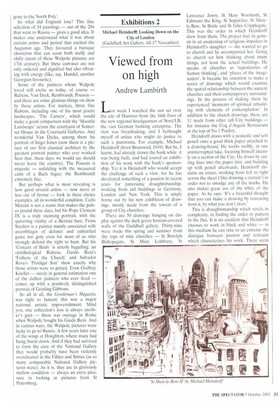Viewed from on high
Andrew Lambirth
Last week I watched the sun set over the city of Hanover from the 16th floor of the new regional headquarters of Nord/LB, the vast German banking enterprise. The view was breathtaking, and I bethought myself of artists who might do justice to such a panorama. For example, Michael Heindorff (born Brunswick 1949). But he, I learnt, had already drawn the bank while it was being built, and had toured an exhibition of his work with the bank's sponsorship. Yet it is Heindorff who would accept the challenge of such a view, for he has developed something of a passion in recent years for panoramic draughtsmanship, working from tall buildings in Germany, London and New York. This is amply borne out by his new exhibition of drawings, mostly made from the towers of a group of City churches.
There are 50 drawings hanging on display against the dark green hessian-covered walls of the Guildhall gallery. Thirty-nine were made this spring and summer from the tops of nine churches — St Botolph Bishopsgate, St Mary Lothbury, St Lawrence Jewry, St Mary Woolnoth, St Edmund the King, St Sepulchre, St Maryle-Bow, St Bride and St Giles Cripplegate. This was the order in which Heindorff drew from them. The project had its genesis in an awakening of religious impulses in Heindorff s daughter — she wanted to go to church and he accompanied her. Going to church set him thinking about many things, not least the actual buildings. He speaks of churches as 'repositories of human thinking', and 'places of the imagination'. It became his intention to make a series of drawings which would examine the spatial relationship between the ancient churches and their contemporary surroundings. In the process of making them he experienced 'moments of spiritual rebuilding with elements of contemplation'. In addition to the church drawings, there are 11 made from other tall City buildings — for instance the Coq d'Argent Restaurant at the top of No 1 Poultry.
Heindorff draws with a penknife and soft pencil onto a good thick paper attached to a drawing-board. He works swiftly, in one uninterrupted take, focusing himself intently on a section of the City. He draws by cutting lines into the paper first, and building up with pencil afterwards. Heindorff disdains an eraser, working from left to right across the sheet (like drawing a curtain') in order not to smudge any of the marks. He also makes great use of the white of the paper. As he says: 'It's a beautiful thought that you can make a drawing by retreating from it, by what you don't draw.'
This is draughtsmanship which revels in complexity, in finding the order or pattern in the flux. It is no accident that Heindorff chooses to work in black and white — in this medium he can take to an extreme the dialogue between passion and restraint which characterises his work. There seem to be two distinct types of drawing at work here — the observational and the conceptual. Heindorff edits what he sees of course (people have complained about his faulty topography, but that is not his prime concern). and mixes up near and far. He draws the shimmer of reflections in plate glass with convincing accuracy and then makes the outline of a crane-hook lurch with cartoon clumsiness across the skyline. It is the meeting of disciplined with undisciplined which gives these drawings their exceptional vitality. Drawing is about shape and tone. line and form.
These are Heindorffs subjects — the panorama is, in a sense, his excuse or justification for using them. The City he depicts is cramped and crowded, part funfair, part building site. At one moment we see a noble spire, at the next what looks like a plastic walkway from a spaceship. The crane-scape of Old London Town is seen through apertures and balustrades, peered at and evoked from odd angles. Different textures and weights of pencil mark are used inventively to convey solidity, distance, reflectivity. Heindorff risks life and limb for his art, venturing up rickety old steps, worn hollow or clogged and slippery with pigeon excrement. He also suffers from vertigo. These enormously skilled and poignant drawings were not made lightly. Despite its title, this is the least condescending of exhibitions.





































































 Previous page
Previous page